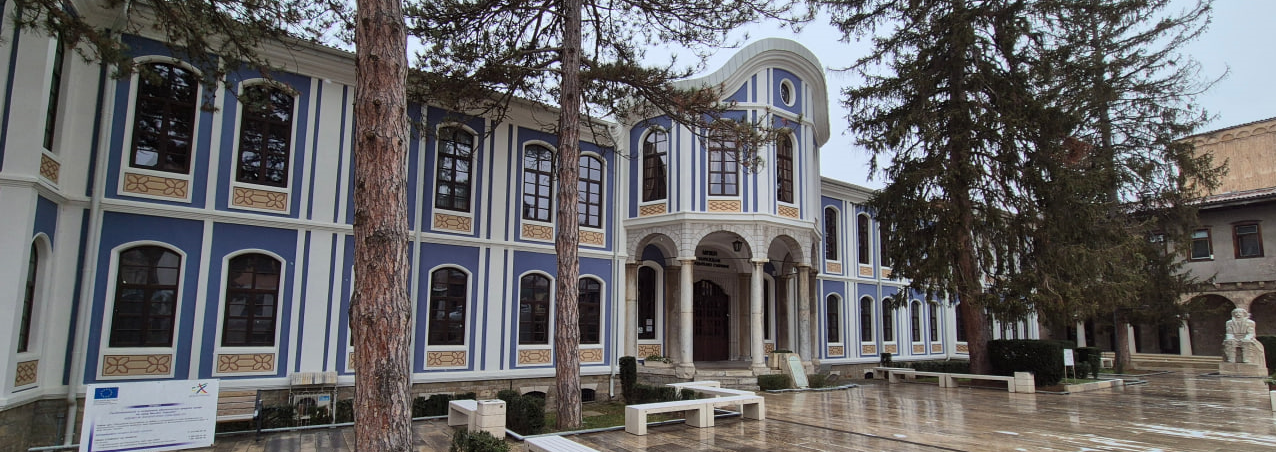The Museum of Revival and Constituent Assembly is located in the northern part of Saedinenie Square (Unification Square) in the city of Veliko Tarnovo, Bulgaria. The museum operates in an old Turkish konak, which was used as a police station during the Ottoman period. This architectural monument was built in 1872 by one of the leading Bulgarian masters of the 19th century, Kolyu Ficheto. The building has two floors on the northern side and four on the southern side, and its transformation into a museum was completed in 1985.

The Museum
Structure and Exhibition Areas of the Museum
The museum collection is spread across three floors, covering different historical periods of Bulgaria. Each floor is designed to highlight specific periods and themes.
First Floor
The development of Christian art in Bulgaria during the Ottoman rule is exhibited on the first floor. The highlight of the exhibition is the icon collection from the Tryavna School of Art, dating back to the mid-16th century. This floor features icons from the 16th century, works from the Tryavna School of Art, and paintings by the first academically trained Bulgarian artists, Stanislav Dospevski and Nikolay Pavlovich. Among the exhibits are royal doors, crosses, church decorations, and icon frames. A shroud dating back to 1559 is also on display.
Additionally, this floor presents exhibits related to the economic development and social life of Veliko Tarnovoduring the Bulgarian Revival Period. Various artifacts from crafts such as goldsmithing, pottery, blacksmithing, leatherworking, and tailoring are displayed. The commercial relations of Veliko Tarnovo, the beginnings of industrialization, and the architectural advancements of the period are illustrated through photographs and models.
Second Floor
This floor showcases the national independence struggle of the Veliko Tarnovoregion during the Ottoman rule. The April Uprising of 1876, the Russo-Turkish War of 1877–1878, the struggle for an independent Bulgarian church, and efforts in education and cultural development are documented. The exhibition includes documents and artifacts related to the Bulgarian people's fight for freedom. Important uprisings and revolutionary movements are displayed through photographs and models.
Third Floor
The third floor features the restored Constituent Assembly Hall, where Bulgaria's first constitution was adopted in 1879. This hall played a crucial role in laying the constitutional foundations of modern Bulgaria. The exhibition includes the seating arrangement of the assembly, the tables where the constitution was signed, and the original furniture used at the time.

The chairs in which Bulgaria Commissioner Pertev Bey and Russian General Dundukov sat during the opening of the Assembly - 1879
Architectural Structure
The museum building is considered an important example of traditional Bulgarian architecture. Designed by Kolyu Ficheto, the building features an arched entrance on the north side, a stone-based wooden construction, a cruciform architectural layout, and typical decorative elements of Bulgarian architecture. The building has two floors on the northern side and four floors on the southern side, adapting to the steep terrain.
Museum Collections and Exhibits
The museum houses a rich collection reflecting Bulgaria's history. Among the most notable exhibits are icons from the 16th century Tryavna School of Art, trade documents from the Ottoman period and beyond, artifacts representing traditional Bulgarian crafts, and models and photographs of buildings designed by Kolyu Ficheto.
Visitor Information
The museum is open to visitors throughout the year, offering guided tours. It can be visited from April to October between 09:00 and 18:00, and from November to March between 09:00 and 17:30. Maintenance work is conducted on Tuesdays from 09:00 to 12:00, and visitor entry ends 30 minutes before closing time. The museum is located at Saedinenie Square 1 in Veliko Tarnovo, and can be reached via bus numbers 20, 40, 50, and 110, with a stop opposite the Tsarevets Fortress.


